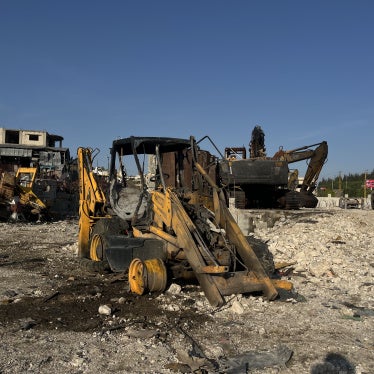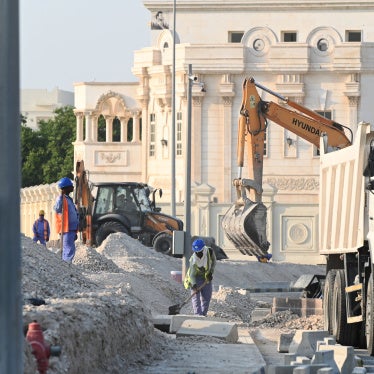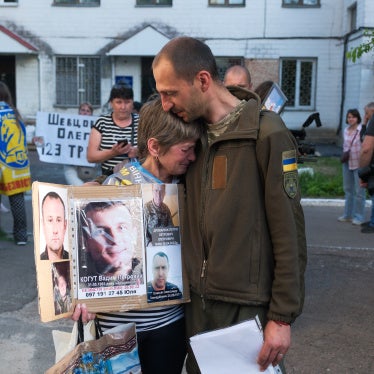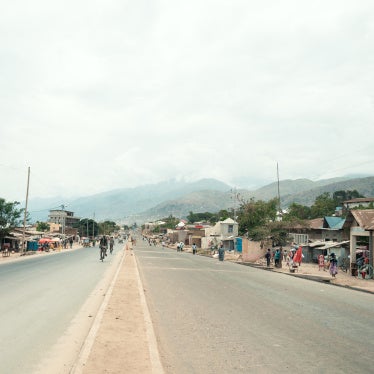Egypt should conduct an impartial investigation into the police use of force against protestors in the industrial city of Mahalla al-Kobra, Human Rights Watch said today. Reports suggest police may have used unnecessary lethal and excessive force in responding to widespread, sometimes violent demonstrations on April 6-7, 2008.
Police in riot gear used live ammunition and rubber bullets to suppress the protests against low wages and price hikes for basic goods, according to eyewitnesses interviewed by Human Rights Watch. A 15-year-old bystander was killed, apparently by police, and more than 100 people were wounded, including some who lost eyes after being shot with rubber-coated bullets. Police detained several journalists trying to cover the protests.
“The question the Egyptian police must answer is how and why a child was killed and dozens were injured by police responding to the Mahalla demonstrations,” said Joe Stork, director of the Middle East and North Africa division at Human Rights Watch. “The evidence from witnesses suggests the police used unnecessary lethal and excessive force.”
Opposition parties and labor leaders in Mahalla, a city 120 kilometers north of Cairo that is home to Egypt’s largest state-owned textile factory, had called for a strike on April 6, two days before country-wide local and municipal council elections. They canceled the strike as hundreds of plainclothes security agents surrounded and entered the Misr Spinning and Weaving factory on the morning of April 6. But after the day shift ended, workers and thousands of Mahalla residents took to the streets in demonstrations that continued the following day.
Police apparently fired the bullets that killed Ahmed Ali Mabrouk Hamada, age 15, in his family’s third-floor apartment near Mahalla’s Jumhuriya square on the night of April 6. The boy’s uncle, Alaa al-Shebini, told Human Rights Watch that “around 11:30 or midnight, Ahmed woke up to the noise [of the demonstrations] in the street, and he went to the balcony to see.” Ahmed was fatally shot shortly after stepping onto the balcony. According to eyewitness bystanders interviewed by Human Rights Watch, no one other than the police fired live ammunition during the demonstrations.
In a related development on the night of April 9, state security forces arrested George Ishak, vice coordinator of the opposition Kifaya movement, at his Cairo home. Ishak’s son told reporters that his father, a well-known pro-democracy activist, was taken away in a civilian car to an unknown location. Khaled Ali, a lawyer at the Hisham Mubarak Law Center, which is representing Ishak, told Human Rights Watch that authorities have charged Ishak with conspiring to organize violent demonstrations and to assault security personnel, resorting to violence to alter the government, and destruction of public and private property. Ali said that as of April 10, Ishak was still being interrogated. He has contacted lawyers but has not been allowed legal representation during his interrogation.
Kifaya had called for nationwide strikes against recent price hikes and on April 3 said it would support demonstrations to be held in Giza, just outside Cairo, in solidarity with the Mahalla workers’ planned strike on April 6. Kifaya founder Abdel-Halim Qandil told the media that police have arrested more than 50 Kifaya members since the protests in Mahalla began on April 6.
Roughly 40 percent of Egypt’s population lives on or around the United Nations’ official poverty line of US$2 per day. According to official Egyptian statistics, staple food prices have increased by 26.5 percent over the past year while middle- and lower-class incomes, according to media reports, remained flat.
On April 5, ahead of the planned protests, the interior ministry condemned the “illegitimate groups” who had called for a strike and promised “the necessary and immediate firm measures against any attempt to demonstrate, block traffic, or hinder public services – or inciting any of these acts.”
Several eyewitnesses to the Mahalla protests told Human Rights Watch that police used rubber bullets and live ammunition as well as tear gas against demonstrators. Mohammed al-Dahab, a reporter for the opposition al-Dustour newspaper, said that on the afternoon of April 6, he saw hundreds of people, many of them young men, gathered in Mahalla’s al-Shown square. “Security advanced on them and started shooting rubber and live bullets. I saw people who [had been] shot, and I saw a man [get] shot in the knee.” Demonstrators fled to side streets and emerged to throw rocks at police, who responded by shooting and attacking the protesters with nightsticks, according to al-Dahab.
Associated Press reports described police in riot gear dragging protestors to the ground and beating them with fists and sticks. Other media reports quoted staff at Mahalla hospital’s emergency department saying said that seven people with critical injuries sustained in the demonstrations had been transferred to the hospital in the nearby city of Mansoura.
The violence in Mahalla apparently began after a crowd tore down an illuminated sign in al-Shown Square depicting President Hosni Mubarak on April 6. A witness who asked not to be identified told Human Rights Watch that he saw police severely beating a demonstrator at around 4 p.m. in response to the sign being torn down. The reporter al-Dahab said he also saw police beating persons in custody on April 6.
Demonstrations were widespread throughout Mahalla and the sequence of violence elsewhere in the town is unclear. Protestors reportedly threw rocks and Molotov cocktails, injuring five policemen in Mahalla’s main square later on Sunday night, and burned two schools and other property. A second witness who requested anonymity told Human Rights Watch that demonstrators set car tires on fire and had looted a restaurant owned by a member of Mubarak’s ruling National Democratic Party.
“The fact that some demonstrations turned violent does not give Egyptian police free license to beat or shoot protestors,” Stork said. “Police have to uphold order, but they should use proper riot-control measures instead of indiscriminately attacking people or using disproportionate force.”
International standards govern the use of force by police and security forces. The UN Code of Conduct for Law Enforcement Officials states that “law enforcement officials may use force only when strictly necessary and to the extent required for the performance of their duty.” The UN Basic Principles on the Use of Force and Firearms call upon law enforcement officials to apply nonviolent means before resorting to the use of force, to use force only in proportion to the seriousness of the offense, and to use lethal force only when strictly unavoidable to protect life.
James Buck, an American freelance journalist who visited the Mahalla textile mill on April 6, described to Human Rights Watch a heavy security presence of plainclothes police inside and surrounding the factory, which remained open.
Buck said that when he attempted to photograph clashes between demonstrators and police on April 6, riot police chased and threw rocks at him. Buck was arrested by police in Mahalla on April 10. It is not clear what charges, if any, he may face. Police detained several other journalists, including an Al Jazeera cameraman and his assistant, as they tried to cover the demonstrations.
News reports quoted government sources stating that security forces had detained more than 300 demonstrators in Mahalla on April 5 and 6. It remains unclear how many remain in detention, or where they are being held. Buck told Human Rights Watch that on April 6, roughly 200 people had gathered outside a police station in downtown Mahalla, asking where their relatives were being held. Many of those in detention were apparently young men or children. The police reportedly told those gathered they could not yet provide a list of all the detainees.
On April 8, Prime Minister Ahmed Nazif visited Mahalla, reportedly promising textile workers a pay bonus of 30 days’ salary and other concessions.






